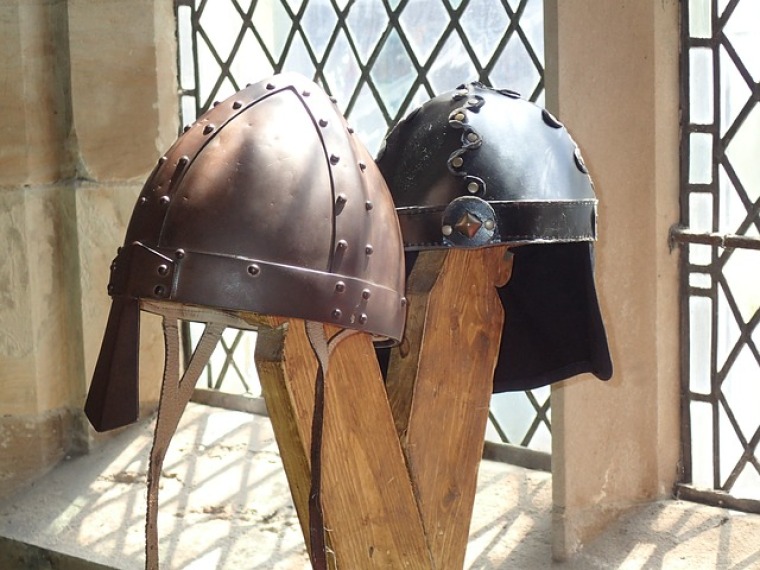Vikings may have been influenced by Islam, new research suggests

Researchers from Uppsala University in Sweden have found the name "Allah" embroidered into 10th Century Norse burial clothes, suggesting that Vikings may have been influenced by Islam.
Kufic characters invoking Allah and Muhammad's cousin and son-in-law, Ali, have been found in woven bands and other items of clothing in two separate grave sites, suggesting that Islam had an influence on Viking funeral customs.
The garments, which were found in ninth and tenth-century graves, were kept in storage for more than 100 years and dismissed as typical examples of Viking Age funeral clothes.
Researchers previously thought that the patterns were ordinary Viking Age decoration, but a re-examination by archaeologist Annika Larsson of Uppsala University revealed they were a geometric Kufic script.
So far, Larsson has found the names on at least 10 of the nearly 100 pieces that she is examining, adding that the names always appear together.
According to Daily Mail, experts previously explained the presence of Islamic artifacts at Viking sites as evidence of looting and trade, but the new findings suggested that there may be closer links between the two cultures.
"It is a staggering thought that the bands, just like the costumes, [were] made west of the Muslim heartland. Presumably, Viking Age burial customs were influenced by Islam and the idea of an eternal life in paradise after death," said Larsson, a researcher in textile archaeology at the Department of Archaeology and Ancient History at Uppsala University.
"In the Quran, it is written that the inhabitants of paradise will wear garments of silk, which along with the text band's inscriptions may explain the widespread occurrence of silk in Viking Age graves. The findings are equally prevalent in both men's and women's graves," she continued.
In her previous research, Larsson examined the widespread use of silk during the Viking Age in Scandinavia.
Her examination of materials, weaving techniques, and design suggested that the cloth originated from Persia and Central Asia.
Ancient texts have indicated that Vikings had been trading with members of the Islamic civilization, which stretched from the Mediterranean to West Asia. It was believed that Viking expeditions have extended from Western Europe to Central Asia, and it is from there that sources indicate the extent to which the Vikings had contact with the Muslim World during ancient times.
Historians in Baghdad and other parts of the Muslim world have reportedly described Vikings as "merchant warriors whose primary focus was on trades."
In 2015, researchers have also unearthed a ring, made over 1,000 years ago, that bears an Arabic inscription that reads "for Allah" or "to Allah."
Larsson and her colleagues have received a positive response from the academic community, but there were reports that their findings had upset some Scandinavians who take pride in their Viking ancestry.
"The negative reactions have come from xenophobes, without any exceptions. It's the Muslim connection that they find particularly disturbing," Larsson said.
 Christians don't have to affirm transgenderism, but they can’t express that view at work: tribunal
Christians don't have to affirm transgenderism, but they can’t express that view at work: tribunal Archaeology discovery: Medieval Christian prayer beads found on Holy Island
Archaeology discovery: Medieval Christian prayer beads found on Holy Island Presbyterian Church in America votes to leave National Association of Evangelicals
Presbyterian Church in America votes to leave National Association of Evangelicals Over 50 killed in 'vile and satanic' attack at Nigerian church on Pentecost Sunday
Over 50 killed in 'vile and satanic' attack at Nigerian church on Pentecost Sunday Ukrainian Orthodox Church severs ties with Moscow over Patriarch Kirill's support for Putin's war
Ukrainian Orthodox Church severs ties with Moscow over Patriarch Kirill's support for Putin's war Islamic State kills 20 Nigerian Christians as revenge for US airstrike
Islamic State kills 20 Nigerian Christians as revenge for US airstrike Man who served 33 years in prison for murder leads inmates to Christ
Man who served 33 years in prison for murder leads inmates to Christ


 Nigerian student beaten to death, body burned over ‘blasphemous’ WhatsApp message
Nigerian student beaten to death, body burned over ‘blasphemous’ WhatsApp message 'A new low': World reacts after Hong Kong arrests 90-year-old Cardinal Joseph Zen
'A new low': World reacts after Hong Kong arrests 90-year-old Cardinal Joseph Zen Iran sentences Christian man to 10 years in prison for hosting house church worship gathering
Iran sentences Christian man to 10 years in prison for hosting house church worship gathering French Guyana: Pastor shot dead, church set on fire after meeting delegation of Evangelicals
French Guyana: Pastor shot dead, church set on fire after meeting delegation of Evangelicals ‘Talking Jesus’ report finds only 6% of UK adults identify as practicing Christians
‘Talking Jesus’ report finds only 6% of UK adults identify as practicing Christians Mission Eurasia ministry center blown up in Ukraine, hundreds of Bibles destroyed: 'God will provide'
Mission Eurasia ministry center blown up in Ukraine, hundreds of Bibles destroyed: 'God will provide' Church holds service for first time after ISIS desecrated it 8 years ago
Church holds service for first time after ISIS desecrated it 8 years ago Burger King apologizes for 'offensive campaign' using Jesus' words at the Last Supper
Burger King apologizes for 'offensive campaign' using Jesus' words at the Last Supper Uganda: Muslims abduct teacher, burn him inside mosque for praying in Christ’s name
Uganda: Muslims abduct teacher, burn him inside mosque for praying in Christ’s name